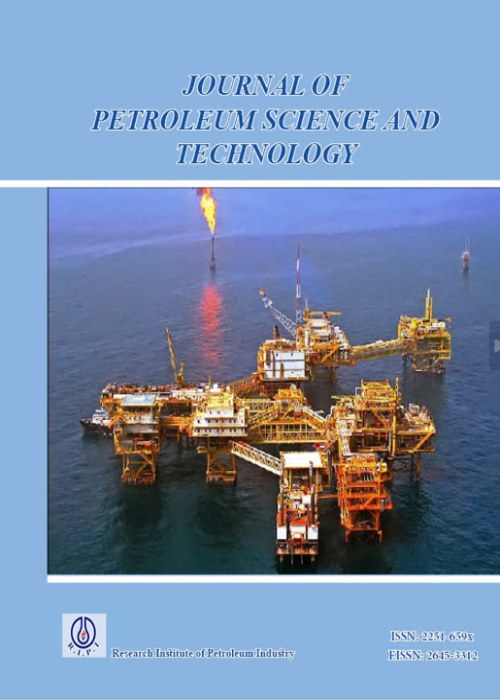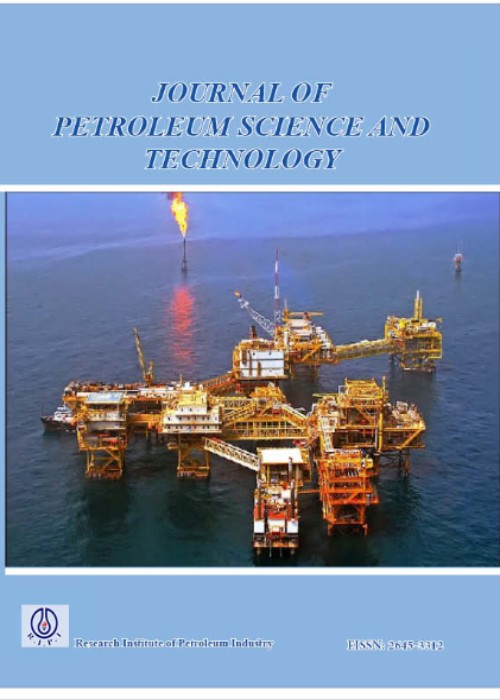فهرست مطالب

Journal of Petroleum Science and Technology
Volume:13 Issue: 1, Winter 2023
- تاریخ انتشار: 1402/09/29
- تعداد عناوین: 6
-
-
Pages 2-15Stylolites are localized dissolution surfaces commonly found in sedimentary rocks. Stylolites have been extensively studied for their important role in controlling porosity and permeability through dissolution, precipitation, deformation, and fluid transport in rocks. Prevalent views are that they act as permeability barriers, although laboratory studies are scarce. Here, we report on a systematic laboratory study of the influence of stylolites on permeability in carbonates. Our data demonstrate that the studied stylolites do not act as barriers to fluid flow. When a stylolite occurs perpendicular to the flow direction, the permeability follows the same power law porosity-permeability trend as the stylolite-free material. Stylolite surfaces can play an effective role as open pathways in increasing the effective porosity of reservoir rock, and due to the wide amplitude range of stylolites, it is necessary to ensure that the permeability of facies increases. The stylolites have been classified into three main types based on their properties such as genesis, general shape, size, the difference in amplitude, amount of accumulated insoluble material in their seams, discontinuity of their seam material, and, most importantly, to predict their role in conducting fluid flow has been explained. However, the direction of dominant stress that determines the genetic type of stylolites and all the effective parameters in the burial diagenetic stage, including the pressure, temperature, and soluble ion-rich fluids, can increase or decrease the porosity and permeability values by draining or blocking the pathway produced by this process through quality assessment of carbonate host rock reservoir. Ultimately, based on this, stylolites in some facies of the Fahliyan Formation in the Abadan Plain Zone act as a continuous and connected porosity for fluid flow and, according to their amplitude and morphology, stylolites increased the effective permeability and reservoir quality, especially in the mud-supported facies in this formation. However, our data affirm that all conditions, especially the nature of morphology, are the most influential parameters determining the porosity and permeability of the Fahliyan Formation facies.Keywords: Stylolite, Morphology, Porosity, Permeability, Fluid Flow, Fahliyan reservoir
-
Pages 16-26Low salinity water flooding has a significant impact on the recovery of carbonate reservoirs. In this paper, the molecular dynamics simulation was carried out to investigate the distribution of ions (Na+, Cl-, Ca2+, Mg2+, and SO42-), water, and oil molecules near the calcite surface (the temperature of 360 K). The results show that the polar component of oil, compared to the non-polar components, tends more to the calcite surface. Additionally, the bulk of oil in brine-containing environments gradually moves away from the surface. Water molecules exhibit simultaneous movement towards the surface, forming two distinct layers near the surface and hydrating the calcite surface. Based on the water’s radial distribution function, it can be observed that the hydrogen atom is closest to the surface within the second layer of water molecules. In contrast, the oxygen atom is in closest proximity to it in the first. Ions displayed concurrent movement towards the surface in conjunction with the motion of water molecules. The ion dispersion gives rise to the forming of an electrical double layer near the surface. Compared to other ions, the closeness of sodium and chlorine ions to the surface leads to creating a layer with a positive charge. The presence of an electrical layer induces the migration of polar oil molecules from the surface. The distribution of Mg2+ and Ca2+ ions indicates that Mg2+ has a stronger surface accumulation tendency than Ca2+.Keywords: Carbonate Reservoir, Low Salinity Water, Ions, Molecular Dynamics Microscopic Displacement in the Reservoir. LSWF
-
Pages 27-40TiO2 nanocomposites on carbonaceous compounds, such as carboxyl-functionalized, multi-walled carbon nanotubes (MWCNT-COOH), and graphene oxide (GO) were synthesized by the sol-gel method. The samples were coded as TiO2 (T), TiO2-MWCNT-COOH (TM), and TiO2-GO (TG). The effect of the addition of carbonaceous compounds on the enhancement of demulsification efficiency of TiO2 nanocomposites in crude oil (W/O) emulsions was then investigated. FT-IR, Raman, and morphological analyses such as FE-SEM, EDXS, XRD, HR-TEM, DRS, BET surface area, and TGA were used to determine the properties and structures of the nanoparticles prepared. In addition, the demulsification efficiency of three nanoparticles was studied under various concentrations, settling times, and temperature conditions by bottle test. According to the screening results, TG was selected as the best sample. The response surface method with a central composite design (CCD) was used to optimize the demulsification activity of TiO2 nanocomposites with graphene oxide (TG). Thus, the impacts of temperature, demulsifier concentration, and time were studied by the RSM-CCD method. Ultimately, the results indicated ~100% demulsification efficiency under optimal conditions at concentration, temperature, and time of 75 ppm, 65oC, and 120 min., respectively.Keywords: TiO2, Carbonaceous Substrates, Sol-Gel, Demulsification, Statistical Methodology
-
Pages 41-48Flue gas stream contains full-oxidized (carbon dioxide), partially oxidized hydrocarbons, and some extent of oxygen. Carbon dioxide can be separated by CO2 capture and separation (CCS) process using monoethanolamine (MEA). In this process, CO2 accompanied with O2 can be absorbed by the solution (MEA+H2O). Dissolved molecular oxygen may explicitly participate in the cathodic reaction and generate sever corrosion problems, or it may induce amine degradation via irreversible oxidative reaction, reducing amine efficiency. In this research, the method of N2-bubbling was investigated for deoxygenation of loaded aqueous MEA solution on a laboratory scale. N2-bubbling set-up was simulated with a known volume glass vessel in which bubbling of N2 with an available flow rate was applied through the loaded amine solution. A mathematical formula was developed to correlate the N2-bubbling flow rate, F, the volume of amine solution in the bubbling column, V, and time taking the oxygen concentration decreases from saturated O2-solution to less than 0.5 mg/L.Keywords: CO2 capture, De-oxygenation, Dissolved oxygen, monoethanolamine solution, N2-Bubbling
-
Pages 49-61Oil/brine electrical behavior could control the wettability of the oil/brine/rock system during low salinity water flooding. However, there is a lack of understanding of chemical reactions occurring on the oil surface. There are a few surface complexation models (SCMs) for the oil/brine interface, and all of them assume that the surface site density is a fixed number, like the mineral surface. The current study assessed two existing models on this subject (Model A and B). These models ignore the dynamic nature of the oil/brine interface. Therefore, they failed to capture experimentally measured ζ potentials appropriately. Therefore, this study constructed a novel diffuse layer SCM (Model C) considering the interfacial concentration of surface carboxylic acid as a function of brine salinity for each salt, including NaCl, Na2SO4, CaCl2, MgCl2, and NaHCO3. Model C matches the experimental data of the literature far better than A and B. Based on Model C, Na+, Cl-, and SO42- cannot be adsorbed on the oil/brine interface; however, the role of these ions in the electrical behavior of crude oil/brine is only to affect the interfacial concentration of -COOH. For example, an increase in Na+ reduced the oil/brine IFT. Therefore, more carboxylic groups would be available at the oil/brine interface. As a result, -COO- concentration increases, and the crude oil surface becomes more negatively charged. The current study indicated that Ca2+ and Mg2+ are not the only factors that make the interface more positively charged. However, an increase in IFT (in this study by salinity reduction) significantly makes the oil/brine interface more positive, too.Keywords: Surface Chemistry, Complexation Model, Interfacial Tension, Zeta Potential
-
Pages 62-66Wellbore instability is a critical problem during oil and gas reservoirs’ drilling and production phase, for which analytical, numerical, experimental, and field methods have been widely discussed. Because of the limitations of the mentioned techniques for predicting the different types of wellbore failures, the problem is still open. Although well logs provide a great source of big data for instability prediction, data-mining techniques have not matured in this domain. This paper explains how an AI-based method can be applied to instability detection/prediction. Unlike other data mining studies in this field, we proposed a systematic approach that can be traceable by the readers. We used several classification algorithms (e.g., Bayesian network, SVM) and found that the C5 decision tree algorithm has the best precision. We show the effectiveness of the method by applying the method to a dataset with about 30,000 records of wellbore logs, getting an accuracy of 91.5%.Keywords: Wellbore Stability, Well Log, Data mining, AI prediction


